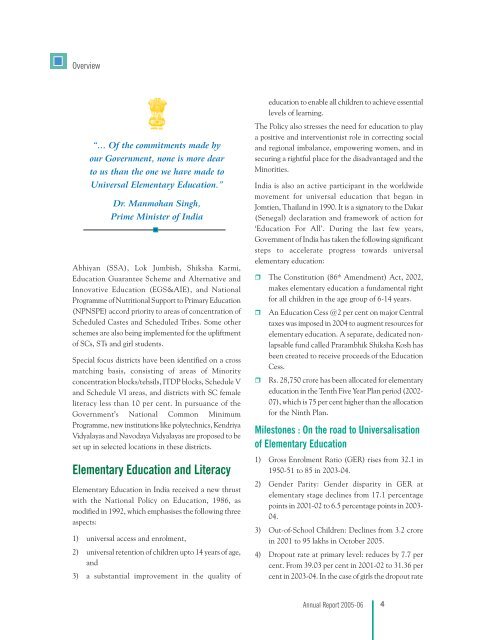all files - Azim Premji Foundation
all files - Azim Premji Foundation
all files - Azim Premji Foundation
You also want an ePaper? Increase the reach of your titles
YUMPU automatically turns print PDFs into web optimized ePapers that Google loves.
Overview<br />
“… Of the commitments made by<br />
our Government, none is more dear<br />
to us than the one we have made to<br />
Universal Elementary Education.”<br />
Dr. Manmohan Singh,<br />
Prime Minister of India<br />
Abhiyan (SSA), Lok Jumbish, Shiksha Karmi,<br />
Education Guarantee Scheme and Alternative and<br />
Innovative Education (EGS&AIE), and National<br />
Programme of Nutritional Support to Primary Education<br />
(NPNSPE) accord priority to areas of concentration of<br />
Scheduled Castes and Scheduled Tribes. Some other<br />
schemes are also being implemented for the upliftment<br />
of SCs, STs and girl students.<br />
Special focus districts have been identified on a cross<br />
matching basis, consisting of areas of Minority<br />
concentration blocks/tehsils, ITDP blocks, Schedule V<br />
and Schedule VI areas, and districts with SC female<br />
literacy less than 10 per cent. In pursuance of the<br />
Government’s National Common Minimum<br />
Programme, new institutions like polytechnics, Kendriya<br />
Vidyalayas and Navodaya Vidyalayas are proposed to be<br />
set up in selected locations in these districts.<br />
Elementary Education and Literacy<br />
Elementary Education in India received a new thrust<br />
with the National Policy on Education, 1986, as<br />
modified in 1992, which emphasises the following three<br />
aspects:<br />
1) universal access and enrolment,<br />
2) universal retention of children upto 14 years of age,<br />
and<br />
3) a substantial improvement in the quality of<br />
education to enable <strong>all</strong> children to achieve essential<br />
levels of learning.<br />
The Policy also stresses the need for education to play<br />
a positive and interventionist role in correcting social<br />
and regional imbalance, empowering women, and in<br />
securing a rightful place for the disadvantaged and the<br />
Minorities.<br />
India is also an active participant in the worldwide<br />
movement for universal education that began in<br />
Jomtien, Thailand in 1990. It is a signatory to the Dakar<br />
(Senegal) declaration and framework of action for<br />
‘Education For All’. During the last few years,<br />
Government of India has taken the following significant<br />
steps to accelerate progress towards universal<br />
elementary education:<br />
r The Constitution (86 th Amendment) Act, 2002,<br />
makes elementary education a fundamental right<br />
for <strong>all</strong> children in the age group of 6-14 years.<br />
r<br />
r<br />
An Education Cess @2 per cent on major Central<br />
taxes was imposed in 2004 to augment resources for<br />
elementary education. A separate, dedicated nonlapsable<br />
fund c<strong>all</strong>ed Prarambhik Shiksha Kosh has<br />
been created to receive proceeds of the Education<br />
Cess.<br />
Rs. 28,750 crore has been <strong>all</strong>ocated for elementary<br />
education in the Tenth Five Year Plan period (2002-<br />
07), which is 75 per cent higher than the <strong>all</strong>ocation<br />
for the Ninth Plan.<br />
Milestones : On the road to Universalisation<br />
of Elementary Education<br />
1) Gross Enrolment Ratio (GER) rises from 32.1 in<br />
1950-51 to 85 in 2003-04.<br />
2) Gender Parity: Gender disparity in GER at<br />
elementary stage declines from 17.1 percentage<br />
points in 2001-02 to 6.5 percentage points in 2003-<br />
04.<br />
3) Out-of-School Children: Declines from 3.2 crore<br />
in 2001 to 95 lakhs in October 2005.<br />
4) Dropout rate at primary level: reduces by 7.7 per<br />
cent. From 39.03 per cent in 2001-02 to 31.36 per<br />
cent in 2003-04. In the case of girls the dropout rate<br />
Annual Report 2005-06<br />
4

















